Comprehensive Marketing Strategy Report: OMO Detergent Analysis
VerifiedAdded on 2022/11/12
|19
|4879
|13
Report
AI Summary
This report provides a comprehensive analysis of OMO, a Unilever detergent brand's marketing strategies. It begins with an executive summary and proceeds with a detailed marketing audit, including PESTEL and SWOT analyses to assess the external and internal environments. The report then delves into OMO's competitive advantages, evaluating its current marketing strategies and discussing the STP (Segmentation, Targeting, and Positioning) approach. Key elements such as market segmentation, targeting strategies, and brand positioning are examined. The report also includes recommended goals and objectives, along with a discussion of OMO's marketing mix. The analysis concludes with insights into how OMO can enhance customer loyalty and maintain its market position, emphasizing the need for continuous research and process redesign to achieve excellent marketing outcomes.
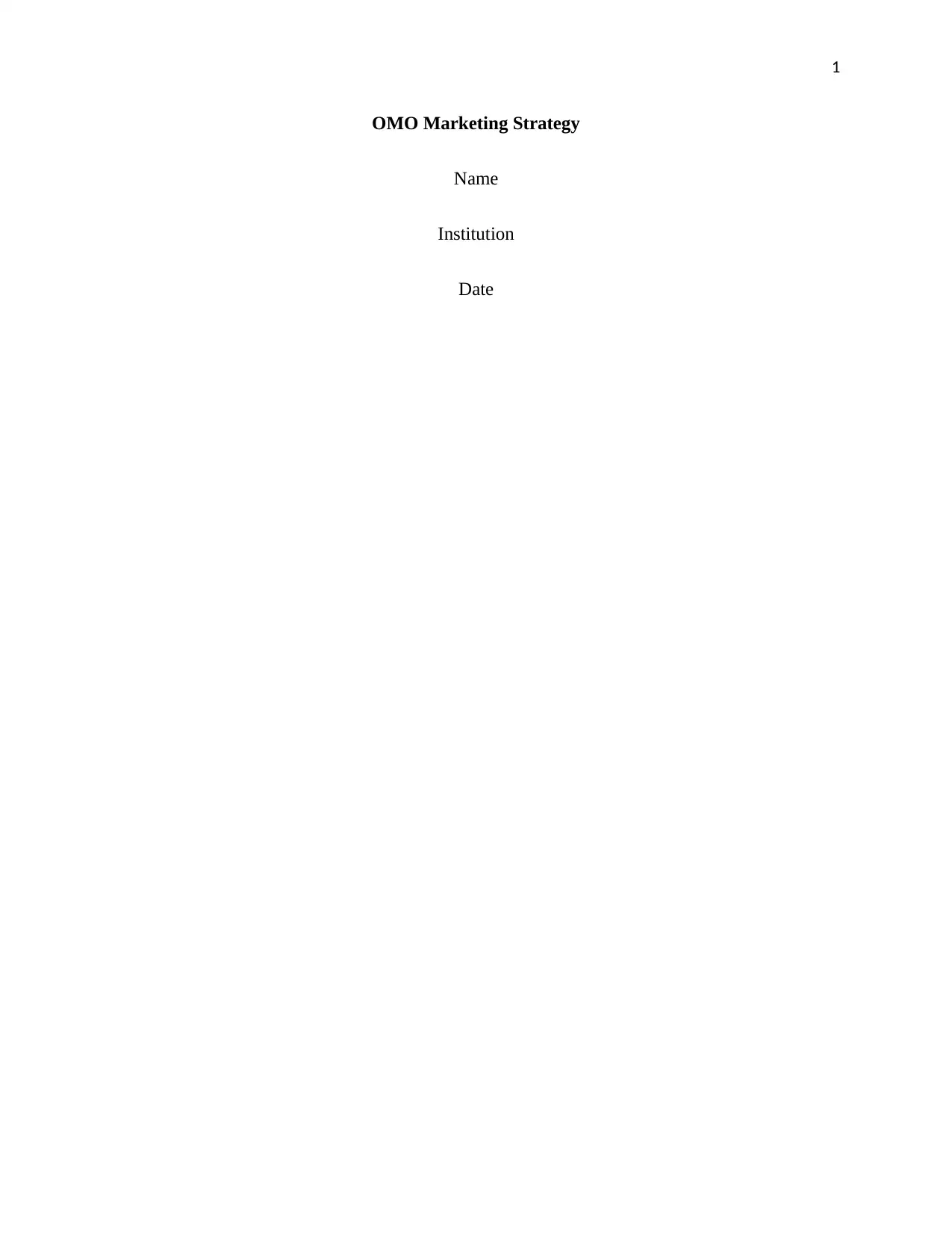
1
OMO Marketing Strategy
Name
Institution
Date
OMO Marketing Strategy
Name
Institution
Date
Paraphrase This Document
Need a fresh take? Get an instant paraphrase of this document with our AI Paraphraser
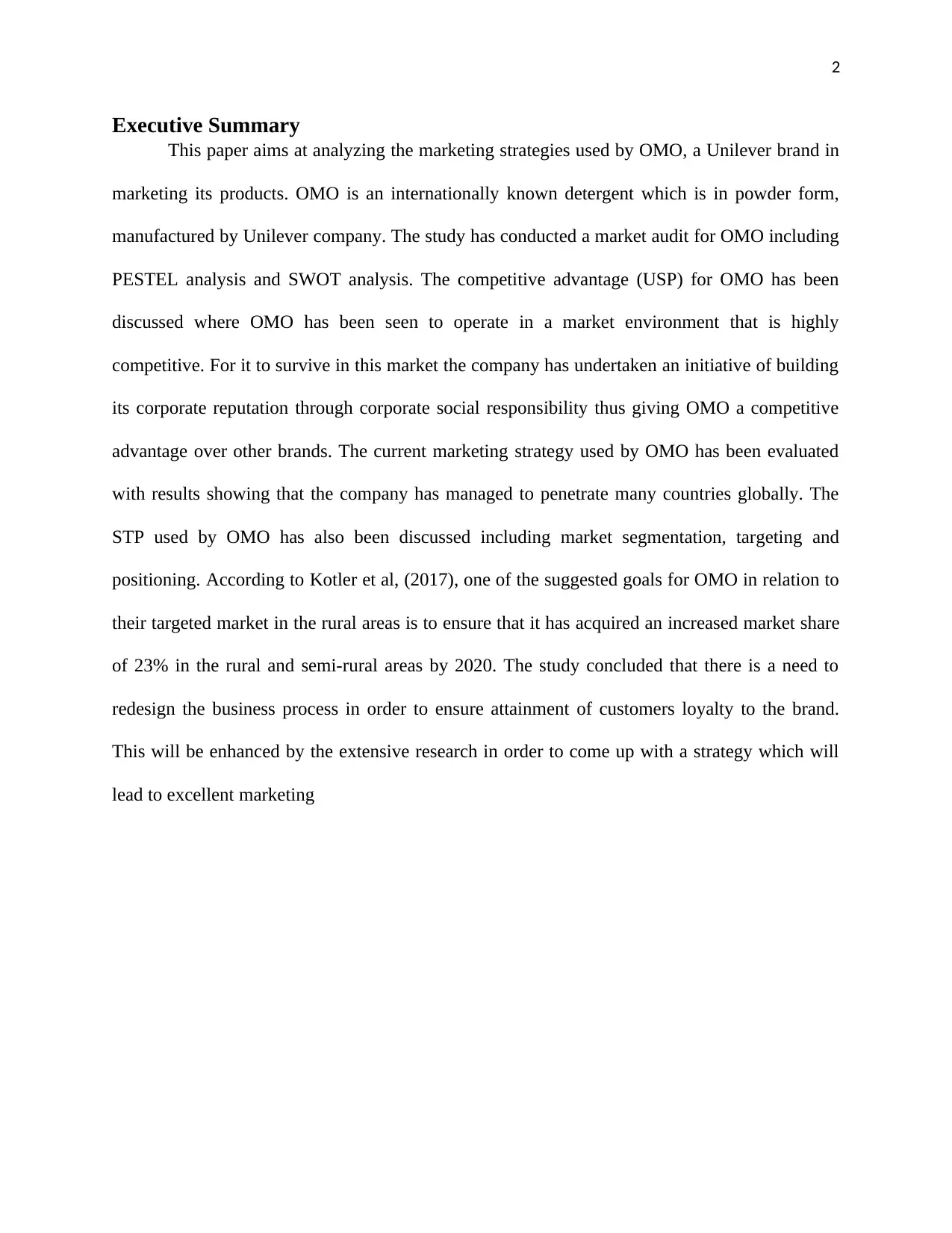
2
Executive Summary
This paper aims at analyzing the marketing strategies used by OMO, a Unilever brand in
marketing its products. OMO is an internationally known detergent which is in powder form,
manufactured by Unilever company. The study has conducted a market audit for OMO including
PESTEL analysis and SWOT analysis. The competitive advantage (USP) for OMO has been
discussed where OMO has been seen to operate in a market environment that is highly
competitive. For it to survive in this market the company has undertaken an initiative of building
its corporate reputation through corporate social responsibility thus giving OMO a competitive
advantage over other brands. The current marketing strategy used by OMO has been evaluated
with results showing that the company has managed to penetrate many countries globally. The
STP used by OMO has also been discussed including market segmentation, targeting and
positioning. According to Kotler et al, (2017), one of the suggested goals for OMO in relation to
their targeted market in the rural areas is to ensure that it has acquired an increased market share
of 23% in the rural and semi-rural areas by 2020. The study concluded that there is a need to
redesign the business process in order to ensure attainment of customers loyalty to the brand.
This will be enhanced by the extensive research in order to come up with a strategy which will
lead to excellent marketing
Executive Summary
This paper aims at analyzing the marketing strategies used by OMO, a Unilever brand in
marketing its products. OMO is an internationally known detergent which is in powder form,
manufactured by Unilever company. The study has conducted a market audit for OMO including
PESTEL analysis and SWOT analysis. The competitive advantage (USP) for OMO has been
discussed where OMO has been seen to operate in a market environment that is highly
competitive. For it to survive in this market the company has undertaken an initiative of building
its corporate reputation through corporate social responsibility thus giving OMO a competitive
advantage over other brands. The current marketing strategy used by OMO has been evaluated
with results showing that the company has managed to penetrate many countries globally. The
STP used by OMO has also been discussed including market segmentation, targeting and
positioning. According to Kotler et al, (2017), one of the suggested goals for OMO in relation to
their targeted market in the rural areas is to ensure that it has acquired an increased market share
of 23% in the rural and semi-rural areas by 2020. The study concluded that there is a need to
redesign the business process in order to ensure attainment of customers loyalty to the brand.
This will be enhanced by the extensive research in order to come up with a strategy which will
lead to excellent marketing
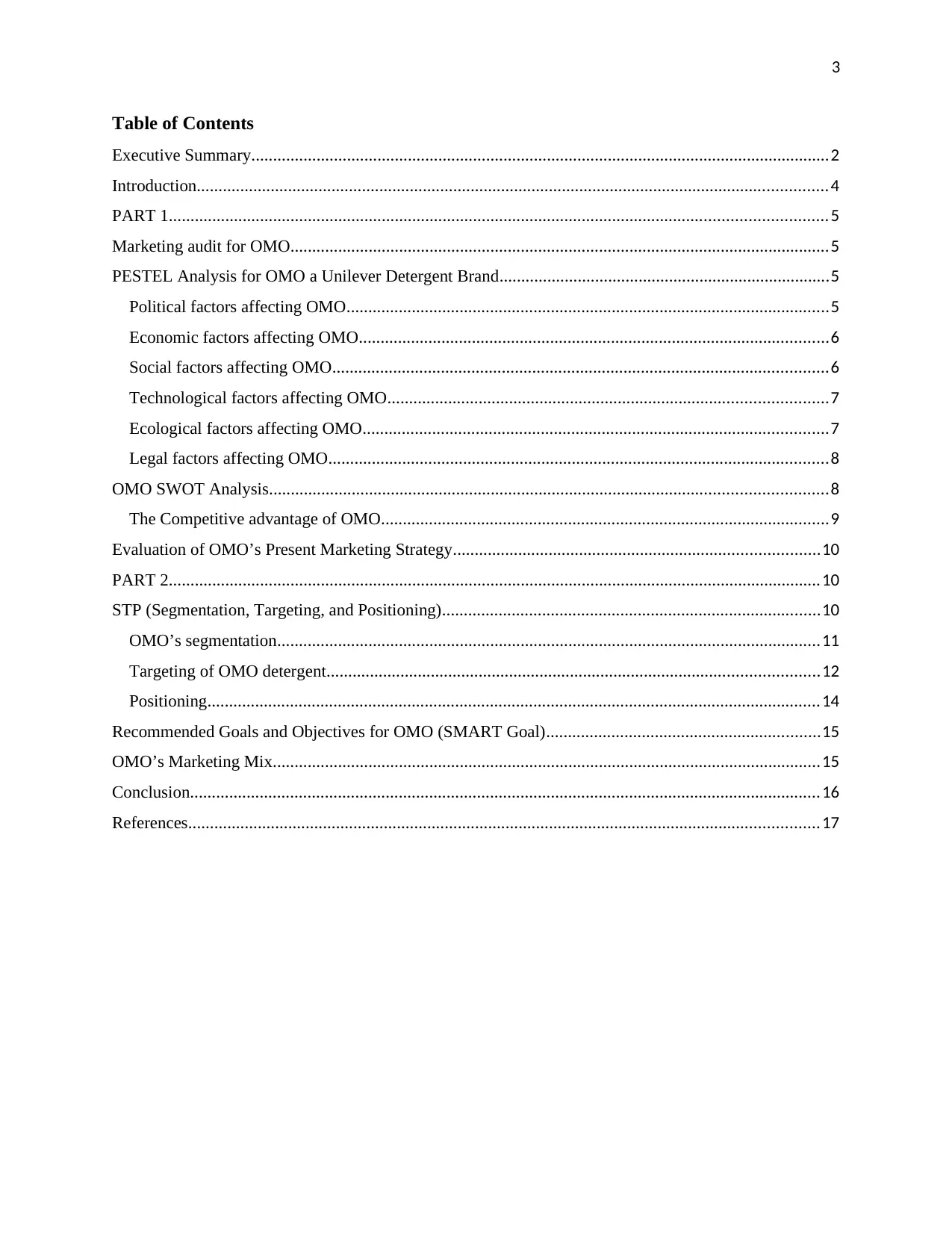
3
Table of Contents
Executive Summary.....................................................................................................................................2
Introduction.................................................................................................................................................4
PART 1.......................................................................................................................................................5
Marketing audit for OMO............................................................................................................................5
PESTEL Analysis for OMO a Unilever Detergent Brand............................................................................5
Political factors affecting OMO...............................................................................................................5
Economic factors affecting OMO............................................................................................................6
Social factors affecting OMO..................................................................................................................6
Technological factors affecting OMO.....................................................................................................7
Ecological factors affecting OMO...........................................................................................................7
Legal factors affecting OMO...................................................................................................................8
OMO SWOT Analysis................................................................................................................................8
The Competitive advantage of OMO.......................................................................................................9
Evaluation of OMO’s Present Marketing Strategy....................................................................................10
PART 2......................................................................................................................................................10
STP (Segmentation, Targeting, and Positioning).......................................................................................10
OMO’s segmentation.............................................................................................................................11
Targeting of OMO detergent.................................................................................................................12
Positioning.............................................................................................................................................14
Recommended Goals and Objectives for OMO (SMART Goal)...............................................................15
OMO’s Marketing Mix..............................................................................................................................15
Conclusion.................................................................................................................................................16
References.................................................................................................................................................17
Table of Contents
Executive Summary.....................................................................................................................................2
Introduction.................................................................................................................................................4
PART 1.......................................................................................................................................................5
Marketing audit for OMO............................................................................................................................5
PESTEL Analysis for OMO a Unilever Detergent Brand............................................................................5
Political factors affecting OMO...............................................................................................................5
Economic factors affecting OMO............................................................................................................6
Social factors affecting OMO..................................................................................................................6
Technological factors affecting OMO.....................................................................................................7
Ecological factors affecting OMO...........................................................................................................7
Legal factors affecting OMO...................................................................................................................8
OMO SWOT Analysis................................................................................................................................8
The Competitive advantage of OMO.......................................................................................................9
Evaluation of OMO’s Present Marketing Strategy....................................................................................10
PART 2......................................................................................................................................................10
STP (Segmentation, Targeting, and Positioning).......................................................................................10
OMO’s segmentation.............................................................................................................................11
Targeting of OMO detergent.................................................................................................................12
Positioning.............................................................................................................................................14
Recommended Goals and Objectives for OMO (SMART Goal)...............................................................15
OMO’s Marketing Mix..............................................................................................................................15
Conclusion.................................................................................................................................................16
References.................................................................................................................................................17
⊘ This is a preview!⊘
Do you want full access?
Subscribe today to unlock all pages.

Trusted by 1+ million students worldwide
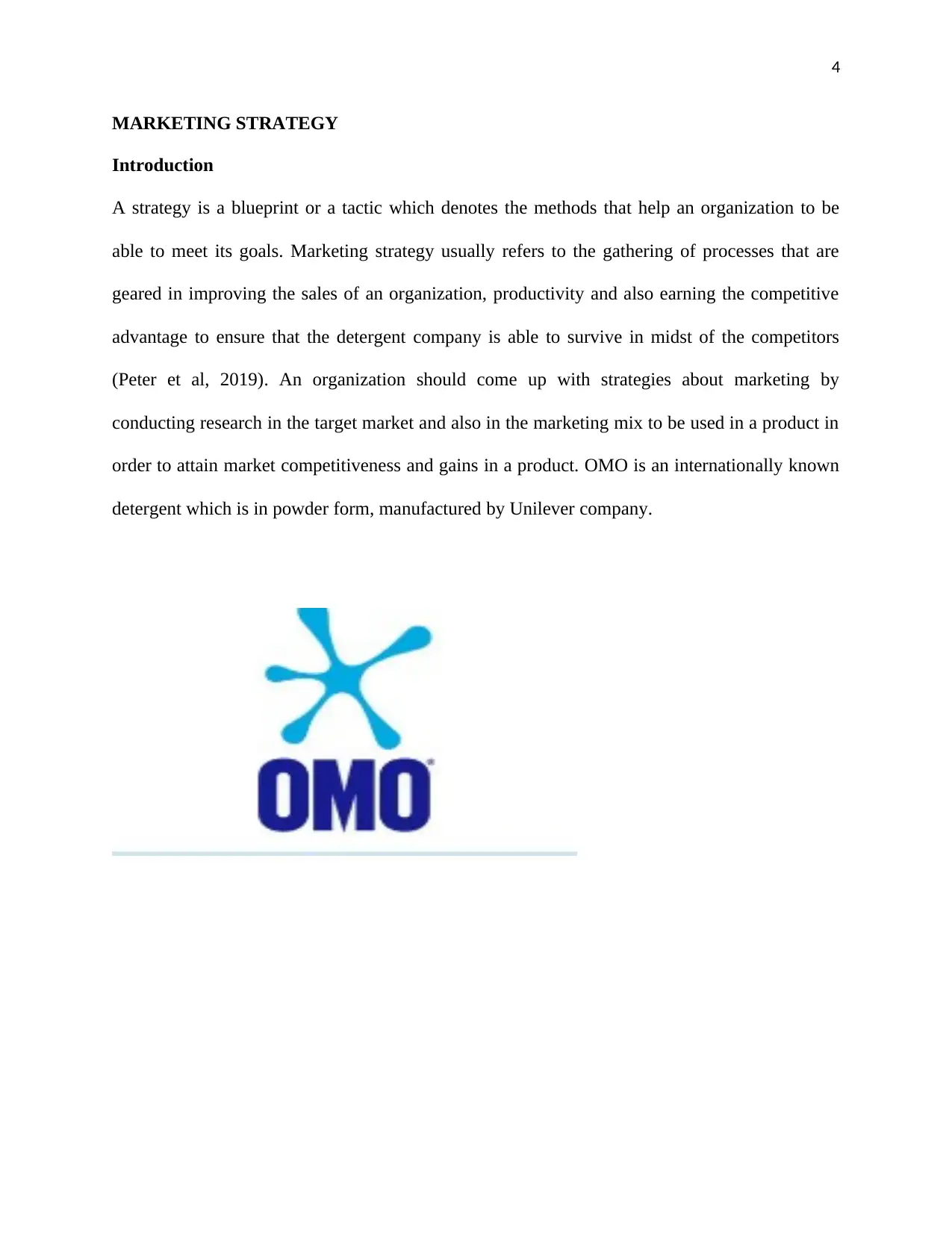
4
MARKETING STRATEGY
Introduction
A strategy is a blueprint or a tactic which denotes the methods that help an organization to be
able to meet its goals. Marketing strategy usually refers to the gathering of processes that are
geared in improving the sales of an organization, productivity and also earning the competitive
advantage to ensure that the detergent company is able to survive in midst of the competitors
(Peter et al, 2019). An organization should come up with strategies about marketing by
conducting research in the target market and also in the marketing mix to be used in a product in
order to attain market competitiveness and gains in a product. OMO is an internationally known
detergent which is in powder form, manufactured by Unilever company.
MARKETING STRATEGY
Introduction
A strategy is a blueprint or a tactic which denotes the methods that help an organization to be
able to meet its goals. Marketing strategy usually refers to the gathering of processes that are
geared in improving the sales of an organization, productivity and also earning the competitive
advantage to ensure that the detergent company is able to survive in midst of the competitors
(Peter et al, 2019). An organization should come up with strategies about marketing by
conducting research in the target market and also in the marketing mix to be used in a product in
order to attain market competitiveness and gains in a product. OMO is an internationally known
detergent which is in powder form, manufactured by Unilever company.
Paraphrase This Document
Need a fresh take? Get an instant paraphrase of this document with our AI Paraphraser
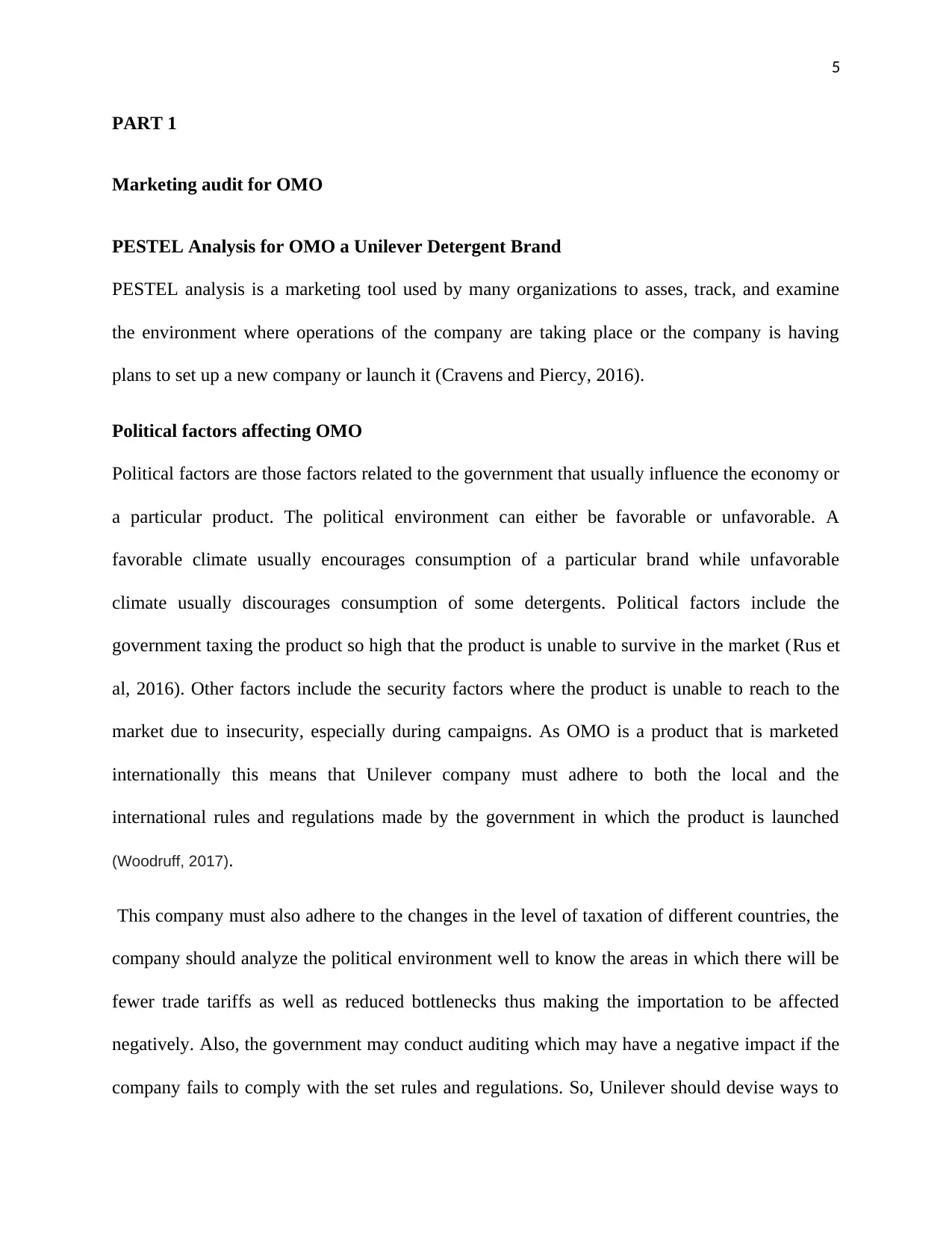
5
PART 1
Marketing audit for OMO
PESTEL Analysis for OMO a Unilever Detergent Brand
PESTEL analysis is a marketing tool used by many organizations to asses, track, and examine
the environment where operations of the company are taking place or the company is having
plans to set up a new company or launch it (Cravens and Piercy, 2016).
Political factors affecting OMO
Political factors are those factors related to the government that usually influence the economy or
a particular product. The political environment can either be favorable or unfavorable. A
favorable climate usually encourages consumption of a particular brand while unfavorable
climate usually discourages consumption of some detergents. Political factors include the
government taxing the product so high that the product is unable to survive in the market (Rus et
al, 2016). Other factors include the security factors where the product is unable to reach to the
market due to insecurity, especially during campaigns. As OMO is a product that is marketed
internationally this means that Unilever company must adhere to both the local and the
international rules and regulations made by the government in which the product is launched
(Woodruff, 2017).
This company must also adhere to the changes in the level of taxation of different countries, the
company should analyze the political environment well to know the areas in which there will be
fewer trade tariffs as well as reduced bottlenecks thus making the importation to be affected
negatively. Also, the government may conduct auditing which may have a negative impact if the
company fails to comply with the set rules and regulations. So, Unilever should devise ways to
PART 1
Marketing audit for OMO
PESTEL Analysis for OMO a Unilever Detergent Brand
PESTEL analysis is a marketing tool used by many organizations to asses, track, and examine
the environment where operations of the company are taking place or the company is having
plans to set up a new company or launch it (Cravens and Piercy, 2016).
Political factors affecting OMO
Political factors are those factors related to the government that usually influence the economy or
a particular product. The political environment can either be favorable or unfavorable. A
favorable climate usually encourages consumption of a particular brand while unfavorable
climate usually discourages consumption of some detergents. Political factors include the
government taxing the product so high that the product is unable to survive in the market (Rus et
al, 2016). Other factors include the security factors where the product is unable to reach to the
market due to insecurity, especially during campaigns. As OMO is a product that is marketed
internationally this means that Unilever company must adhere to both the local and the
international rules and regulations made by the government in which the product is launched
(Woodruff, 2017).
This company must also adhere to the changes in the level of taxation of different countries, the
company should analyze the political environment well to know the areas in which there will be
fewer trade tariffs as well as reduced bottlenecks thus making the importation to be affected
negatively. Also, the government may conduct auditing which may have a negative impact if the
company fails to comply with the set rules and regulations. So, Unilever should devise ways to
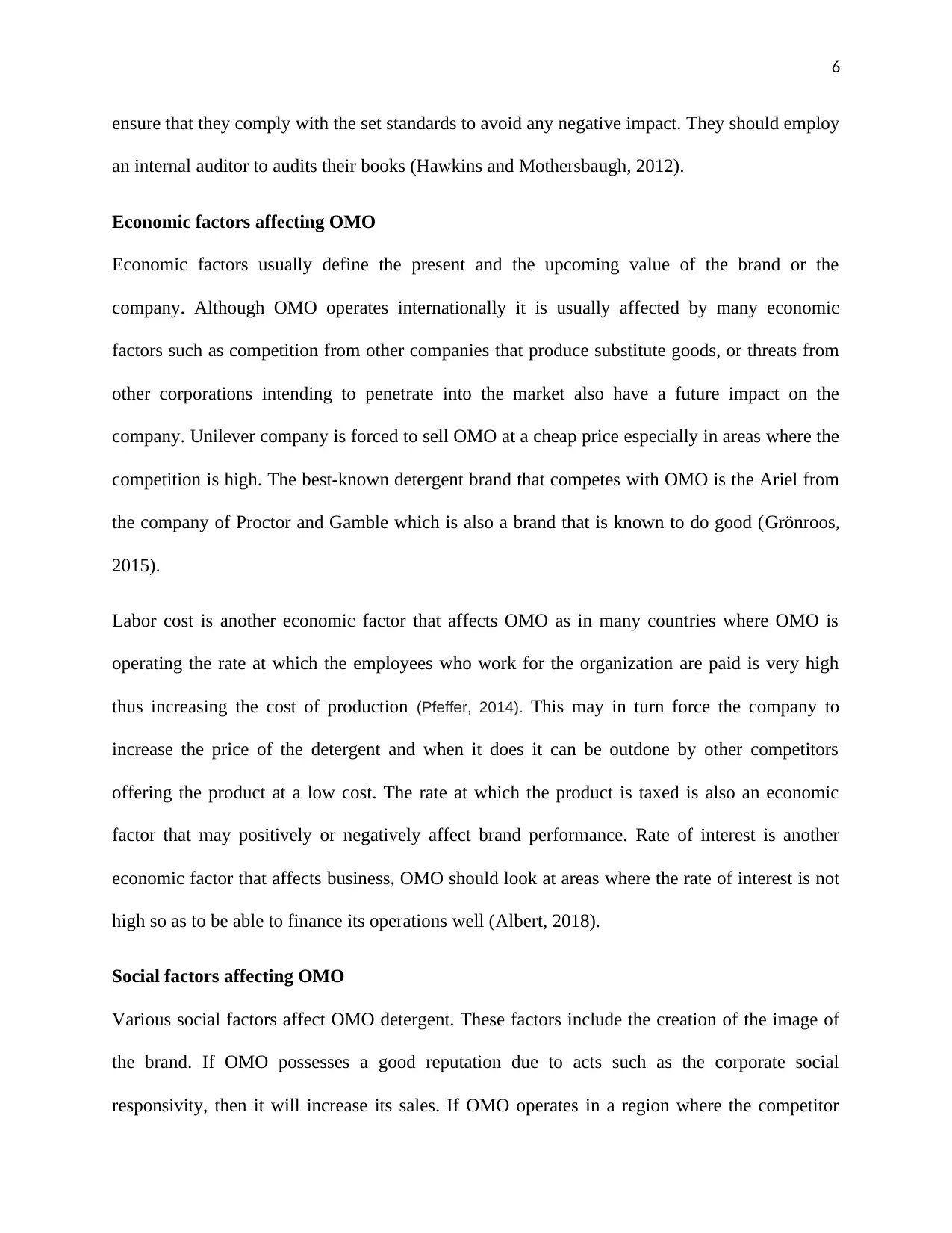
6
ensure that they comply with the set standards to avoid any negative impact. They should employ
an internal auditor to audits their books (Hawkins and Mothersbaugh, 2012).
Economic factors affecting OMO
Economic factors usually define the present and the upcoming value of the brand or the
company. Although OMO operates internationally it is usually affected by many economic
factors such as competition from other companies that produce substitute goods, or threats from
other corporations intending to penetrate into the market also have a future impact on the
company. Unilever company is forced to sell OMO at a cheap price especially in areas where the
competition is high. The best-known detergent brand that competes with OMO is the Ariel from
the company of Proctor and Gamble which is also a brand that is known to do good (Grönroos,
2015).
Labor cost is another economic factor that affects OMO as in many countries where OMO is
operating the rate at which the employees who work for the organization are paid is very high
thus increasing the cost of production (Pfeffer, 2014). This may in turn force the company to
increase the price of the detergent and when it does it can be outdone by other competitors
offering the product at a low cost. The rate at which the product is taxed is also an economic
factor that may positively or negatively affect brand performance. Rate of interest is another
economic factor that affects business, OMO should look at areas where the rate of interest is not
high so as to be able to finance its operations well (Albert, 2018).
Social factors affecting OMO
Various social factors affect OMO detergent. These factors include the creation of the image of
the brand. If OMO possesses a good reputation due to acts such as the corporate social
responsivity, then it will increase its sales. If OMO operates in a region where the competitor
ensure that they comply with the set standards to avoid any negative impact. They should employ
an internal auditor to audits their books (Hawkins and Mothersbaugh, 2012).
Economic factors affecting OMO
Economic factors usually define the present and the upcoming value of the brand or the
company. Although OMO operates internationally it is usually affected by many economic
factors such as competition from other companies that produce substitute goods, or threats from
other corporations intending to penetrate into the market also have a future impact on the
company. Unilever company is forced to sell OMO at a cheap price especially in areas where the
competition is high. The best-known detergent brand that competes with OMO is the Ariel from
the company of Proctor and Gamble which is also a brand that is known to do good (Grönroos,
2015).
Labor cost is another economic factor that affects OMO as in many countries where OMO is
operating the rate at which the employees who work for the organization are paid is very high
thus increasing the cost of production (Pfeffer, 2014). This may in turn force the company to
increase the price of the detergent and when it does it can be outdone by other competitors
offering the product at a low cost. The rate at which the product is taxed is also an economic
factor that may positively or negatively affect brand performance. Rate of interest is another
economic factor that affects business, OMO should look at areas where the rate of interest is not
high so as to be able to finance its operations well (Albert, 2018).
Social factors affecting OMO
Various social factors affect OMO detergent. These factors include the creation of the image of
the brand. If OMO possesses a good reputation due to acts such as the corporate social
responsivity, then it will increase its sales. If OMO operates in a region where the competitor
⊘ This is a preview!⊘
Do you want full access?
Subscribe today to unlock all pages.

Trusted by 1+ million students worldwide
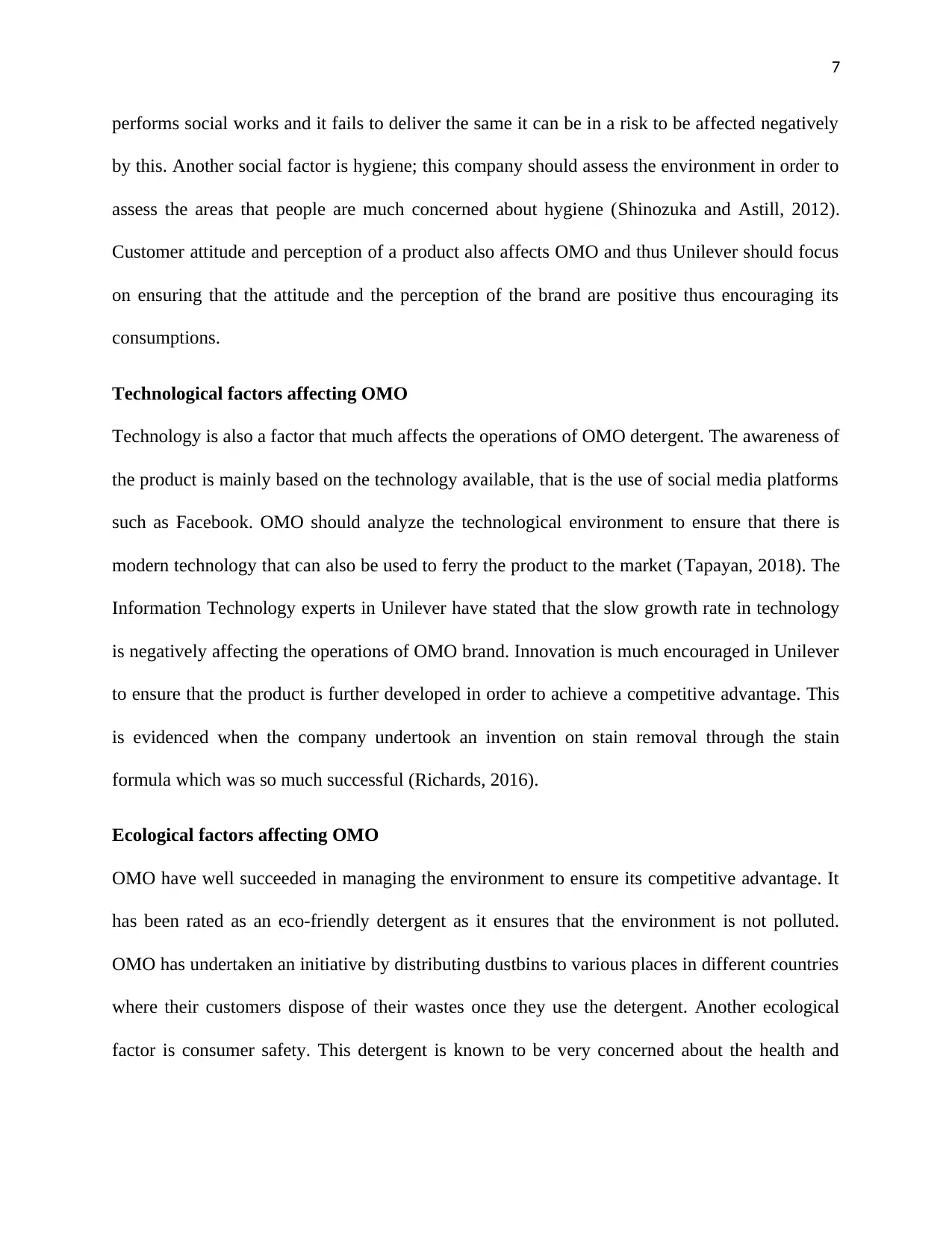
7
performs social works and it fails to deliver the same it can be in a risk to be affected negatively
by this. Another social factor is hygiene; this company should assess the environment in order to
assess the areas that people are much concerned about hygiene (Shinozuka and Astill, 2012).
Customer attitude and perception of a product also affects OMO and thus Unilever should focus
on ensuring that the attitude and the perception of the brand are positive thus encouraging its
consumptions.
Technological factors affecting OMO
Technology is also a factor that much affects the operations of OMO detergent. The awareness of
the product is mainly based on the technology available, that is the use of social media platforms
such as Facebook. OMO should analyze the technological environment to ensure that there is
modern technology that can also be used to ferry the product to the market (Tapayan, 2018). The
Information Technology experts in Unilever have stated that the slow growth rate in technology
is negatively affecting the operations of OMO brand. Innovation is much encouraged in Unilever
to ensure that the product is further developed in order to achieve a competitive advantage. This
is evidenced when the company undertook an invention on stain removal through the stain
formula which was so much successful (Richards, 2016).
Ecological factors affecting OMO
OMO have well succeeded in managing the environment to ensure its competitive advantage. It
has been rated as an eco-friendly detergent as it ensures that the environment is not polluted.
OMO has undertaken an initiative by distributing dustbins to various places in different countries
where their customers dispose of their wastes once they use the detergent. Another ecological
factor is consumer safety. This detergent is known to be very concerned about the health and
performs social works and it fails to deliver the same it can be in a risk to be affected negatively
by this. Another social factor is hygiene; this company should assess the environment in order to
assess the areas that people are much concerned about hygiene (Shinozuka and Astill, 2012).
Customer attitude and perception of a product also affects OMO and thus Unilever should focus
on ensuring that the attitude and the perception of the brand are positive thus encouraging its
consumptions.
Technological factors affecting OMO
Technology is also a factor that much affects the operations of OMO detergent. The awareness of
the product is mainly based on the technology available, that is the use of social media platforms
such as Facebook. OMO should analyze the technological environment to ensure that there is
modern technology that can also be used to ferry the product to the market (Tapayan, 2018). The
Information Technology experts in Unilever have stated that the slow growth rate in technology
is negatively affecting the operations of OMO brand. Innovation is much encouraged in Unilever
to ensure that the product is further developed in order to achieve a competitive advantage. This
is evidenced when the company undertook an invention on stain removal through the stain
formula which was so much successful (Richards, 2016).
Ecological factors affecting OMO
OMO have well succeeded in managing the environment to ensure its competitive advantage. It
has been rated as an eco-friendly detergent as it ensures that the environment is not polluted.
OMO has undertaken an initiative by distributing dustbins to various places in different countries
where their customers dispose of their wastes once they use the detergent. Another ecological
factor is consumer safety. This detergent is known to be very concerned about the health and
Paraphrase This Document
Need a fresh take? Get an instant paraphrase of this document with our AI Paraphraser
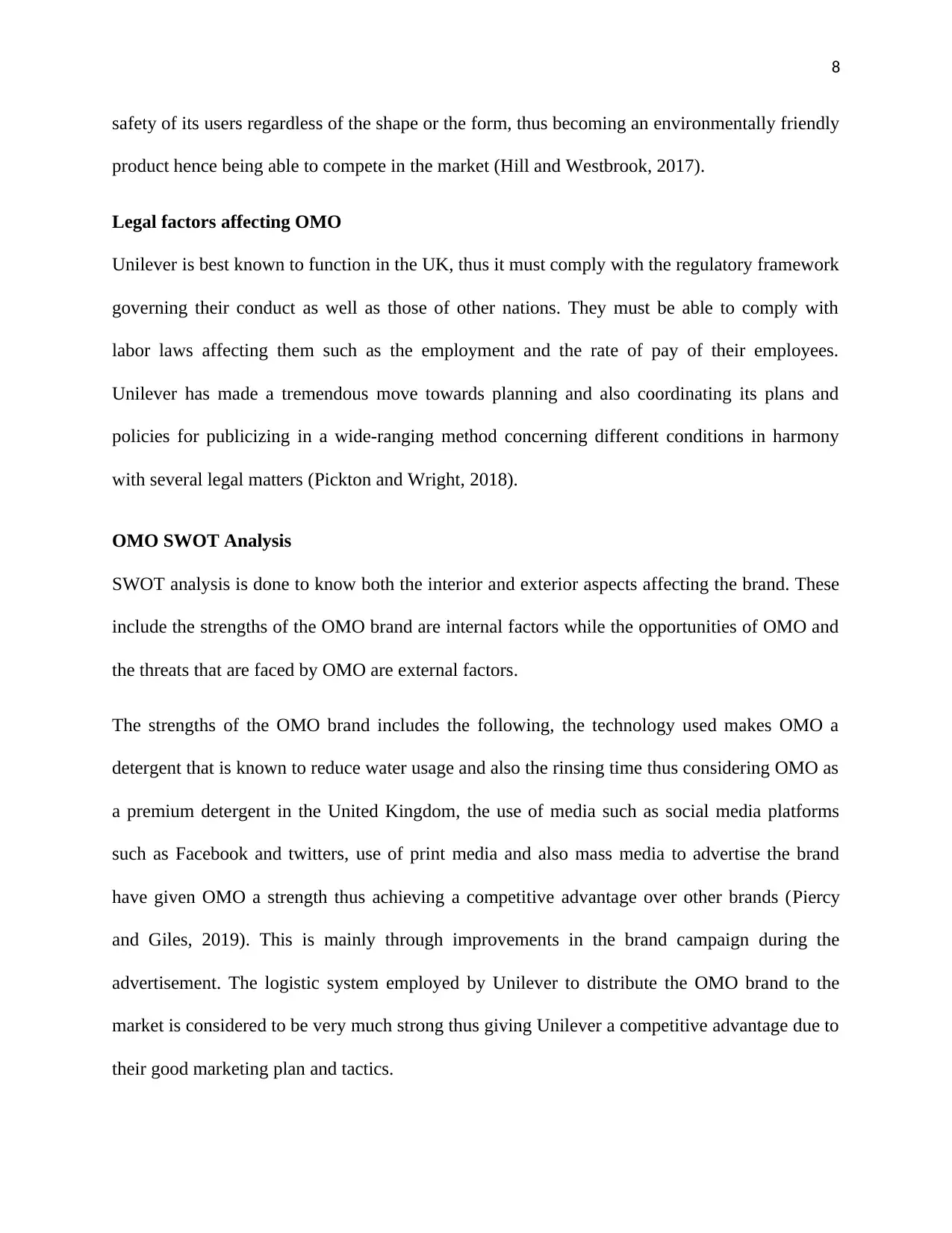
8
safety of its users regardless of the shape or the form, thus becoming an environmentally friendly
product hence being able to compete in the market (Hill and Westbrook, 2017).
Legal factors affecting OMO
Unilever is best known to function in the UK, thus it must comply with the regulatory framework
governing their conduct as well as those of other nations. They must be able to comply with
labor laws affecting them such as the employment and the rate of pay of their employees.
Unilever has made a tremendous move towards planning and also coordinating its plans and
policies for publicizing in a wide-ranging method concerning different conditions in harmony
with several legal matters (Pickton and Wright, 2018).
OMO SWOT Analysis
SWOT analysis is done to know both the interior and exterior aspects affecting the brand. These
include the strengths of the OMO brand are internal factors while the opportunities of OMO and
the threats that are faced by OMO are external factors.
The strengths of the OMO brand includes the following, the technology used makes OMO a
detergent that is known to reduce water usage and also the rinsing time thus considering OMO as
a premium detergent in the United Kingdom, the use of media such as social media platforms
such as Facebook and twitters, use of print media and also mass media to advertise the brand
have given OMO a strength thus achieving a competitive advantage over other brands (Piercy
and Giles, 2019). This is mainly through improvements in the brand campaign during the
advertisement. The logistic system employed by Unilever to distribute the OMO brand to the
market is considered to be very much strong thus giving Unilever a competitive advantage due to
their good marketing plan and tactics.
safety of its users regardless of the shape or the form, thus becoming an environmentally friendly
product hence being able to compete in the market (Hill and Westbrook, 2017).
Legal factors affecting OMO
Unilever is best known to function in the UK, thus it must comply with the regulatory framework
governing their conduct as well as those of other nations. They must be able to comply with
labor laws affecting them such as the employment and the rate of pay of their employees.
Unilever has made a tremendous move towards planning and also coordinating its plans and
policies for publicizing in a wide-ranging method concerning different conditions in harmony
with several legal matters (Pickton and Wright, 2018).
OMO SWOT Analysis
SWOT analysis is done to know both the interior and exterior aspects affecting the brand. These
include the strengths of the OMO brand are internal factors while the opportunities of OMO and
the threats that are faced by OMO are external factors.
The strengths of the OMO brand includes the following, the technology used makes OMO a
detergent that is known to reduce water usage and also the rinsing time thus considering OMO as
a premium detergent in the United Kingdom, the use of media such as social media platforms
such as Facebook and twitters, use of print media and also mass media to advertise the brand
have given OMO a strength thus achieving a competitive advantage over other brands (Piercy
and Giles, 2019). This is mainly through improvements in the brand campaign during the
advertisement. The logistic system employed by Unilever to distribute the OMO brand to the
market is considered to be very much strong thus giving Unilever a competitive advantage due to
their good marketing plan and tactics.
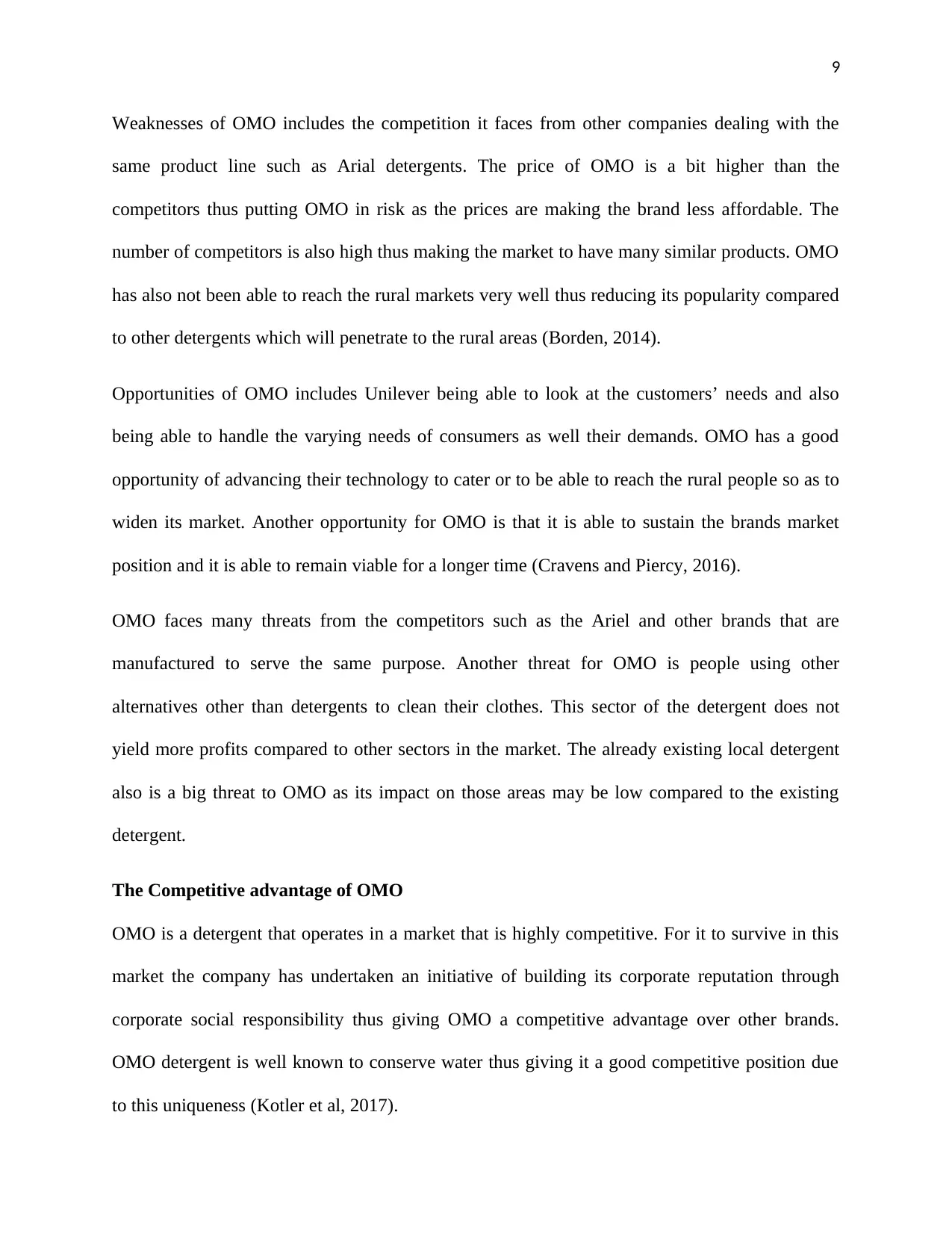
9
Weaknesses of OMO includes the competition it faces from other companies dealing with the
same product line such as Arial detergents. The price of OMO is a bit higher than the
competitors thus putting OMO in risk as the prices are making the brand less affordable. The
number of competitors is also high thus making the market to have many similar products. OMO
has also not been able to reach the rural markets very well thus reducing its popularity compared
to other detergents which will penetrate to the rural areas (Borden, 2014).
Opportunities of OMO includes Unilever being able to look at the customers’ needs and also
being able to handle the varying needs of consumers as well their demands. OMO has a good
opportunity of advancing their technology to cater or to be able to reach the rural people so as to
widen its market. Another opportunity for OMO is that it is able to sustain the brands market
position and it is able to remain viable for a longer time (Cravens and Piercy, 2016).
OMO faces many threats from the competitors such as the Ariel and other brands that are
manufactured to serve the same purpose. Another threat for OMO is people using other
alternatives other than detergents to clean their clothes. This sector of the detergent does not
yield more profits compared to other sectors in the market. The already existing local detergent
also is a big threat to OMO as its impact on those areas may be low compared to the existing
detergent.
The Competitive advantage of OMO
OMO is a detergent that operates in a market that is highly competitive. For it to survive in this
market the company has undertaken an initiative of building its corporate reputation through
corporate social responsibility thus giving OMO a competitive advantage over other brands.
OMO detergent is well known to conserve water thus giving it a good competitive position due
to this uniqueness (Kotler et al, 2017).
Weaknesses of OMO includes the competition it faces from other companies dealing with the
same product line such as Arial detergents. The price of OMO is a bit higher than the
competitors thus putting OMO in risk as the prices are making the brand less affordable. The
number of competitors is also high thus making the market to have many similar products. OMO
has also not been able to reach the rural markets very well thus reducing its popularity compared
to other detergents which will penetrate to the rural areas (Borden, 2014).
Opportunities of OMO includes Unilever being able to look at the customers’ needs and also
being able to handle the varying needs of consumers as well their demands. OMO has a good
opportunity of advancing their technology to cater or to be able to reach the rural people so as to
widen its market. Another opportunity for OMO is that it is able to sustain the brands market
position and it is able to remain viable for a longer time (Cravens and Piercy, 2016).
OMO faces many threats from the competitors such as the Ariel and other brands that are
manufactured to serve the same purpose. Another threat for OMO is people using other
alternatives other than detergents to clean their clothes. This sector of the detergent does not
yield more profits compared to other sectors in the market. The already existing local detergent
also is a big threat to OMO as its impact on those areas may be low compared to the existing
detergent.
The Competitive advantage of OMO
OMO is a detergent that operates in a market that is highly competitive. For it to survive in this
market the company has undertaken an initiative of building its corporate reputation through
corporate social responsibility thus giving OMO a competitive advantage over other brands.
OMO detergent is well known to conserve water thus giving it a good competitive position due
to this uniqueness (Kotler et al, 2017).
⊘ This is a preview!⊘
Do you want full access?
Subscribe today to unlock all pages.

Trusted by 1+ million students worldwide
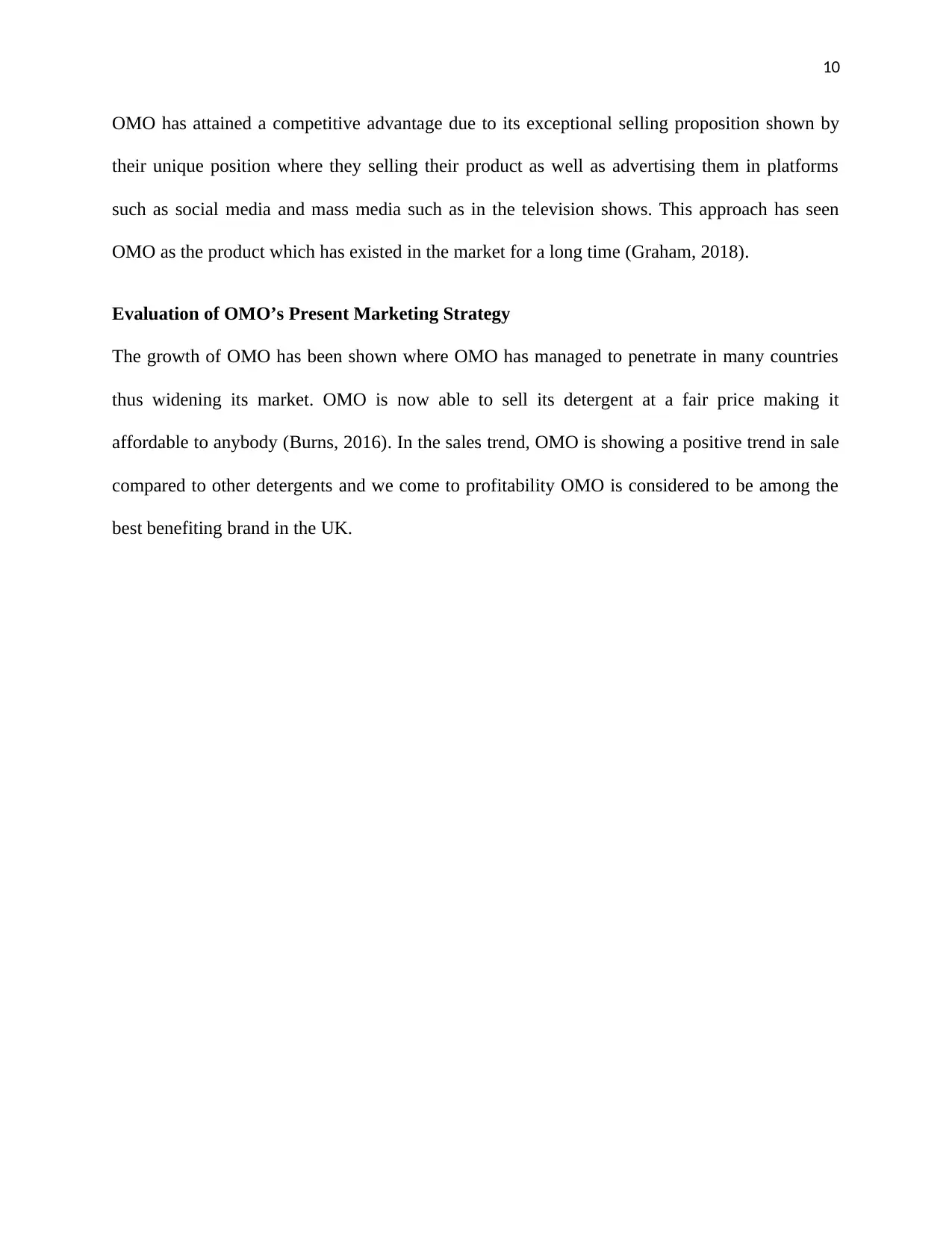
10
OMO has attained a competitive advantage due to its exceptional selling proposition shown by
their unique position where they selling their product as well as advertising them in platforms
such as social media and mass media such as in the television shows. This approach has seen
OMO as the product which has existed in the market for a long time (Graham, 2018).
Evaluation of OMO’s Present Marketing Strategy
The growth of OMO has been shown where OMO has managed to penetrate in many countries
thus widening its market. OMO is now able to sell its detergent at a fair price making it
affordable to anybody (Burns, 2016). In the sales trend, OMO is showing a positive trend in sale
compared to other detergents and we come to profitability OMO is considered to be among the
best benefiting brand in the UK.
OMO has attained a competitive advantage due to its exceptional selling proposition shown by
their unique position where they selling their product as well as advertising them in platforms
such as social media and mass media such as in the television shows. This approach has seen
OMO as the product which has existed in the market for a long time (Graham, 2018).
Evaluation of OMO’s Present Marketing Strategy
The growth of OMO has been shown where OMO has managed to penetrate in many countries
thus widening its market. OMO is now able to sell its detergent at a fair price making it
affordable to anybody (Burns, 2016). In the sales trend, OMO is showing a positive trend in sale
compared to other detergents and we come to profitability OMO is considered to be among the
best benefiting brand in the UK.
Paraphrase This Document
Need a fresh take? Get an instant paraphrase of this document with our AI Paraphraser
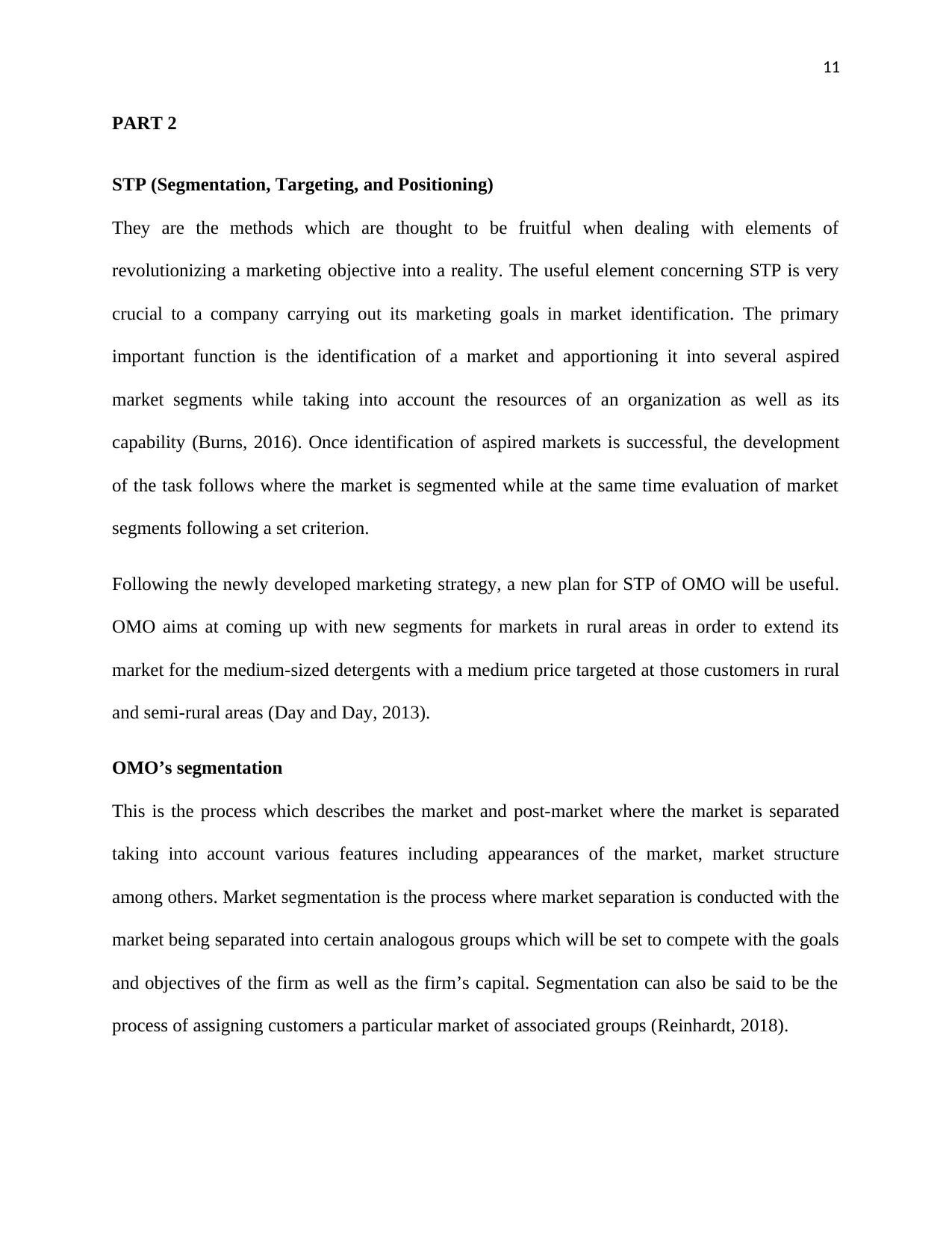
11
PART 2
STP (Segmentation, Targeting, and Positioning)
They are the methods which are thought to be fruitful when dealing with elements of
revolutionizing a marketing objective into a reality. The useful element concerning STP is very
crucial to a company carrying out its marketing goals in market identification. The primary
important function is the identification of a market and apportioning it into several aspired
market segments while taking into account the resources of an organization as well as its
capability (Burns, 2016). Once identification of aspired markets is successful, the development
of the task follows where the market is segmented while at the same time evaluation of market
segments following a set criterion.
Following the newly developed marketing strategy, a new plan for STP of OMO will be useful.
OMO aims at coming up with new segments for markets in rural areas in order to extend its
market for the medium-sized detergents with a medium price targeted at those customers in rural
and semi-rural areas (Day and Day, 2013).
OMO’s segmentation
This is the process which describes the market and post-market where the market is separated
taking into account various features including appearances of the market, market structure
among others. Market segmentation is the process where market separation is conducted with the
market being separated into certain analogous groups which will be set to compete with the goals
and objectives of the firm as well as the firm’s capital. Segmentation can also be said to be the
process of assigning customers a particular market of associated groups (Reinhardt, 2018).
PART 2
STP (Segmentation, Targeting, and Positioning)
They are the methods which are thought to be fruitful when dealing with elements of
revolutionizing a marketing objective into a reality. The useful element concerning STP is very
crucial to a company carrying out its marketing goals in market identification. The primary
important function is the identification of a market and apportioning it into several aspired
market segments while taking into account the resources of an organization as well as its
capability (Burns, 2016). Once identification of aspired markets is successful, the development
of the task follows where the market is segmented while at the same time evaluation of market
segments following a set criterion.
Following the newly developed marketing strategy, a new plan for STP of OMO will be useful.
OMO aims at coming up with new segments for markets in rural areas in order to extend its
market for the medium-sized detergents with a medium price targeted at those customers in rural
and semi-rural areas (Day and Day, 2013).
OMO’s segmentation
This is the process which describes the market and post-market where the market is separated
taking into account various features including appearances of the market, market structure
among others. Market segmentation is the process where market separation is conducted with the
market being separated into certain analogous groups which will be set to compete with the goals
and objectives of the firm as well as the firm’s capital. Segmentation can also be said to be the
process of assigning customers a particular market of associated groups (Reinhardt, 2018).
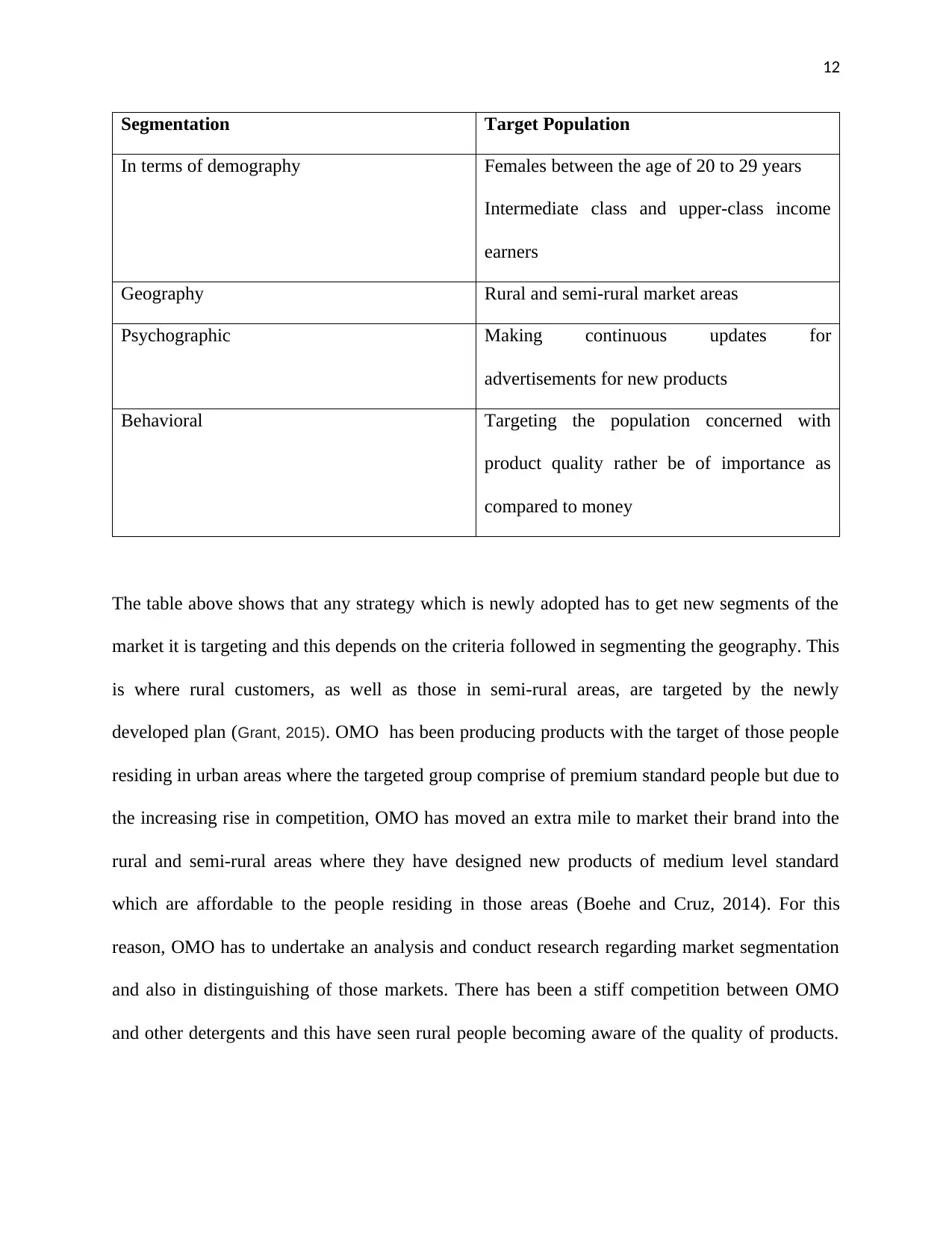
12
Segmentation Target Population
In terms of demography Females between the age of 20 to 29 years
Intermediate class and upper-class income
earners
Geography Rural and semi-rural market areas
Psychographic Making continuous updates for
advertisements for new products
Behavioral Targeting the population concerned with
product quality rather be of importance as
compared to money
The table above shows that any strategy which is newly adopted has to get new segments of the
market it is targeting and this depends on the criteria followed in segmenting the geography. This
is where rural customers, as well as those in semi-rural areas, are targeted by the newly
developed plan (Grant, 2015). OMO has been producing products with the target of those people
residing in urban areas where the targeted group comprise of premium standard people but due to
the increasing rise in competition, OMO has moved an extra mile to market their brand into the
rural and semi-rural areas where they have designed new products of medium level standard
which are affordable to the people residing in those areas (Boehe and Cruz, 2014). For this
reason, OMO has to undertake an analysis and conduct research regarding market segmentation
and also in distinguishing of those markets. There has been a stiff competition between OMO
and other detergents and this have seen rural people becoming aware of the quality of products.
Segmentation Target Population
In terms of demography Females between the age of 20 to 29 years
Intermediate class and upper-class income
earners
Geography Rural and semi-rural market areas
Psychographic Making continuous updates for
advertisements for new products
Behavioral Targeting the population concerned with
product quality rather be of importance as
compared to money
The table above shows that any strategy which is newly adopted has to get new segments of the
market it is targeting and this depends on the criteria followed in segmenting the geography. This
is where rural customers, as well as those in semi-rural areas, are targeted by the newly
developed plan (Grant, 2015). OMO has been producing products with the target of those people
residing in urban areas where the targeted group comprise of premium standard people but due to
the increasing rise in competition, OMO has moved an extra mile to market their brand into the
rural and semi-rural areas where they have designed new products of medium level standard
which are affordable to the people residing in those areas (Boehe and Cruz, 2014). For this
reason, OMO has to undertake an analysis and conduct research regarding market segmentation
and also in distinguishing of those markets. There has been a stiff competition between OMO
and other detergents and this have seen rural people becoming aware of the quality of products.
⊘ This is a preview!⊘
Do you want full access?
Subscribe today to unlock all pages.

Trusted by 1+ million students worldwide
1 out of 19
Related Documents
Your All-in-One AI-Powered Toolkit for Academic Success.
+13062052269
info@desklib.com
Available 24*7 on WhatsApp / Email
![[object Object]](/_next/static/media/star-bottom.7253800d.svg)
Unlock your academic potential
Copyright © 2020–2025 A2Z Services. All Rights Reserved. Developed and managed by ZUCOL.




